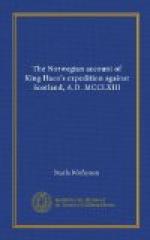19.
The champions of Nordmaera’s[92] Lord saluted the stout, harnassed Barons, with the rough music of battle. The train of the supporter of thrones, courageous, and clad in steel, marched to the din of clashing swords.
20.
At the conflict of corselets on the blood-red hill, the damasked blade hewed the mail of hostile tribes, ere the Scot, nimble as the hound, would leave the field to the followers of our all-conquering king.
The Scotch then left the eminence, and fled, where they could, away to their mountains. The Norwegians, perceiving this, retired to their boats, and rowing out to their ships, luckily escaped the storm. On the morning they came back in search of the bodies of those who had dropt. Among the dead were Haco of Steini, and Thorgisl Gloppa, both belonging to King Haco’s household. There fell also a worthy vassal called Karlhoved, from Drontheim, and another vassal named Halkel, from Fiorde. Besides, there died three Masters of the Lights, Thorstein Bat, John Ballhoved, and Halward Buniard. It was impossible for the Norwegians to tell how many were killed of the Scotch, because those who dropt were taken up and removed to the woods. King Haco ordered his dead to be carried to a church.
Five days after, King Haco commanded his men to weigh anchor and to bring his ship close under the Cumbras. He was soon joined by the squadron which had been in Loch-long. On the fast day following, the weather was good, and the King sent some retainers ashore to burn the vessels which had been stranded; that same day the King sailed past Cumbra to Melansey,[93] where he lay some nights. Here he was met by the Commissioners he had sent to Ireland, who assured him that the Irish Ostmen would willingly engage to maintain his army till he freed them from the dominion of the English. King Haco was extremely desirous of sailing for Ireland, and, as the wind was not favourable, he held a Council on the subject, but the whole army was against this plan. He, therefore, told them that as he was short of provisions he would steer for the Hebrides. The King then ordered the body of Ivar Holm to be carried to Bute, where it was interred.
Afterwards King Haco sailed past Melansey and lay some nights near Arran, then proceeded to Sandey and so to the Mull of Kintire, and at night he arrived north at Gudey; next he sailed out to Ila-sound, where he remained two nights. King Haco laid a contribution, rated at three hundred head of cattle, on the island, but part was to be paid in meal, part in cheese. Haco set sail again on the first Sunday of winter, and met a fog and a storm so violent that few of the ships could carry their sails. The king, therefore, made for Kiararey, and about this time messengers passed between him and King John, but to little purpose. Here the King was informed that his troops had made depredations in Mull, and that some of the Mull-men, with two or three Norwegians, had been killed.




